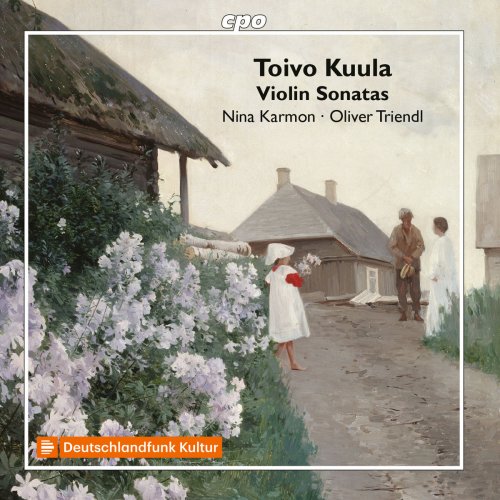
Nina Karmon & Oliver Triendl - Kuula: Works for Violin & Piano (2018)
BAND/ARTIST: Nina Karmon & Oliver Triendl
- Title: Kuula: Works for Violin & Piano
- Year Of Release: 2018
- Label: CPO
- Genre: Classical
- Quality: flac lossless
- Total Time: 01:10:32
- Total Size: 401 mb
- WebSite: Album Preview
Tracklist
---------
01. Violin Sonata in E Minor, Op. 1: I. Allegro agitato
02. Violin Sonata in E Minor, Op. 1: II. Adagio
03. Violin Sonata in E Minor, Op. 1: III. Allegro molto
04. 5 Pieces for Violin & Piano, Op. 3a: No. 1, Kehtolaulu
05. 5 Pieces for Violin & Piano, Op. 3a: No. 2, Notturno
06. 5 Pieces for Violin & Piano, Op. 3a: No. 3, Kansanlaulu I
07. 5 Pieces for Violin & Piano, Op. 3a: No. 4, Kansanlaulu II
08. 5 Pieces for Violin & Piano, Op. 3a: No. 5, Scherzino
09. Ut min väg i världen går (Version for Violin & Piano)
10. Elä itke impeni nuori (Version for Violin & Piano)
11. Violin Sonata in F Major
12. 2 Pieces for Violin & Piano, Op. 22: No. 1, Joululaulu
13. 2 Pieces for Violin & Piano, Op. 22: No. 2, Suru
14. South Ostrobothnian Suite No. 1, Op. 9: No. 3, Pohjalainen tanssi (Version for Violin & Piano)
15. Kesäilta (Version for Violin & Piano)
Although Toivo Kuula was one of the few pupils taught by Sibelius, he never really had to struggle to emerge from his teacher’s shadow into his own independent light. Kuula originally had wanted to be a violinist and continued to favour the violin even after the playing of this instrument had receded into the background and his activities as a composer had come to occupy the foreground. The Sonata Movement of 1906 already attests to the composer’s remarkable mastery in the design of musical processes. The essential difference between this piece and the Violin Sonata Op. 1 composed during the following year, when Kuula was a student in Helsinki, is that in the latter work his own voice is present from the very beginning. As a press report demonstrates, its premiere at the Music Academy in Helsinki in 1907 turned out to be a great success for the composer, who was not yet twenty-four years old. The critic Karl Flodin (1858-1925) remarked: “The sonata is not a pupil’s composition but the product of a mature, independent, and brilliant talent […]. [It] has atmosphere, imagination, poetry, and power, with a strong expression of will.”
---------
01. Violin Sonata in E Minor, Op. 1: I. Allegro agitato
02. Violin Sonata in E Minor, Op. 1: II. Adagio
03. Violin Sonata in E Minor, Op. 1: III. Allegro molto
04. 5 Pieces for Violin & Piano, Op. 3a: No. 1, Kehtolaulu
05. 5 Pieces for Violin & Piano, Op. 3a: No. 2, Notturno
06. 5 Pieces for Violin & Piano, Op. 3a: No. 3, Kansanlaulu I
07. 5 Pieces for Violin & Piano, Op. 3a: No. 4, Kansanlaulu II
08. 5 Pieces for Violin & Piano, Op. 3a: No. 5, Scherzino
09. Ut min väg i världen går (Version for Violin & Piano)
10. Elä itke impeni nuori (Version for Violin & Piano)
11. Violin Sonata in F Major
12. 2 Pieces for Violin & Piano, Op. 22: No. 1, Joululaulu
13. 2 Pieces for Violin & Piano, Op. 22: No. 2, Suru
14. South Ostrobothnian Suite No. 1, Op. 9: No. 3, Pohjalainen tanssi (Version for Violin & Piano)
15. Kesäilta (Version for Violin & Piano)
Although Toivo Kuula was one of the few pupils taught by Sibelius, he never really had to struggle to emerge from his teacher’s shadow into his own independent light. Kuula originally had wanted to be a violinist and continued to favour the violin even after the playing of this instrument had receded into the background and his activities as a composer had come to occupy the foreground. The Sonata Movement of 1906 already attests to the composer’s remarkable mastery in the design of musical processes. The essential difference between this piece and the Violin Sonata Op. 1 composed during the following year, when Kuula was a student in Helsinki, is that in the latter work his own voice is present from the very beginning. As a press report demonstrates, its premiere at the Music Academy in Helsinki in 1907 turned out to be a great success for the composer, who was not yet twenty-four years old. The critic Karl Flodin (1858-1925) remarked: “The sonata is not a pupil’s composition but the product of a mature, independent, and brilliant talent […]. [It] has atmosphere, imagination, poetry, and power, with a strong expression of will.”
Year 2018 | Classical | FLAC / APE
As a ISRA.CLOUD's PREMIUM member you will have the following benefits:
- Unlimited high speed downloads
- Download directly without waiting time
- Unlimited parallel downloads
- Support for download accelerators
- No advertising
- Resume broken downloads


